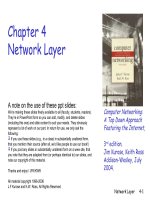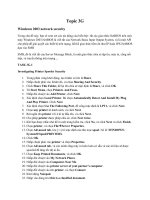External or internal network adapters
Bạn đang xem bản rút gọn của tài liệu. Xem và tải ngay bản đầy đủ của tài liệu tại đây (722.43 KB, 39 trang )
1
Copyright © 2011 Pearson Education, Inc. Publishing as Prentice Hall
2
Technology in Action
Technology in Action
Chapter 7
Chapter 7
Networking:
Networking:
Connecting Computing Devices
Connecting Computing Devices
Copyright © 2011 Pearson Education, Inc. Publishing as Prentice Hall
3
Chapter Topics
Chapter Topics
•
Networking fundamentals
•
Network architecture
•
Network components
•
Peer-to-peer networks
•
Ethernet networks
•
Power-line networks
•
Configuring software
•
Wireless security
Copyright © 2011 Pearson Education, Inc. Publishing as Prentice Hall
4
Networking Fundamentals
Networking Fundamentals
•
Computer network
–
Two or more computers connected together
–
Devices connected to networks: nodes
•
Benefits of a network
–
Sharing resources and peripherals
–
Transferring files
–
Sharing of broadband connection with use of
a router
Copyright © 2011 Pearson Education, Inc. Publishing as Prentice Hall
5
Network Architecture
Network Architecture
•
Network designs
–
Locally administered
•
Peer-to-peer (P2P)
–
Centrally administered
•
Client/server
Copyright © 2011 Pearson Education, Inc. Publishing as Prentice Hall
6
Peer-to-Peer Networks
Peer-to-Peer Networks
•
Nodes communicate with each other
–
Peers
•
Share peripheral devices
•
Common in home networks
Copyright © 2011 Pearson Education, Inc. Publishing as Prentice Hall
7
Client/Server Networks
Client/Server Networks
•
Client computers
–
Users who make requests
•
Server computers
–
Provide resources to
clients
–
Central network control
•
Internet
–
A large, multiserver,
multiclient network
Copyright © 2011 Pearson Education, Inc. Publishing as Prentice Hall
8
HANs and LANs
HANs and LANs
•
Home area network (HAN)
–
Connects digital devices within a home
•
Local area network (LAN)
–
Nodes are within a small geographic region
•
Schools
•
Small businesses
Copyright © 2011 Pearson Education, Inc. Publishing as Prentice Hall
9
WANs and MANs
WANs and MANs
•
Wide area network (WAN)
–
LANs connected over long distances
•
A few miles to thousands of miles
•
Uses telecommunications lines
•
Metropolitan area network (MAN)
–
Provides access within a specific geographic
region, such as a city
Copyright © 2011 Pearson Education, Inc. Publishing as Prentice Hall
10
Network Components
Network Components
•
Transmission media
•
Network
communication
devices
•
Software
Copyright © 2011 Pearson Education, Inc. Publishing as Prentice Hall
11
Transmission Media
Transmission Media
•
Provide communications channel between
nodes
•
Forms of media
–
Twisted pair cable
–
Coaxial cable
–
Fiber-optic cable
–
Radio waves (wireless)
•
Bandwidth
–
Data transfer rate
–
Throughput
Copyright © 2011 Pearson Education, Inc. Publishing as Prentice Hall
12
Network Adapters
Network Adapters
•
Devices connected to or installed in nodes
–
Network interface cards (NICs)
–
External or internal network adapters
•
Enable communication between nodes
Copyright © 2011 Pearson Education, Inc. Publishing as Prentice Hall
13
Network Navigation Devices
Network Navigation Devices
•
Devices that help make data flow
possible
•
Routers
–
Route data between networks
•
Switches
–
Receive data and retransmit it to nodes on
the same network
Copyright © 2011 Pearson Education, Inc. Publishing as Prentice Hall
14
Networking Software
Networking Software
•
Peer-to-peer software
–
Built into operating systems that support
networking
•
Windows
•
Mac OS
•
Linux
Copyright © 2011 Pearson Education, Inc. Publishing as Prentice Hall
15
Networking Software
Networking Software
•
Client/server software
–
Network operating system (NOS) software
•
Windows Server 2008
•
SUSE Linux Enterprise
Copyright © 2011 Pearson Education, Inc. Publishing as Prentice Hall
16
Types of Peer-to-Peer Networks
Types of Peer-to-Peer Networks
•
Wired Ethernet networks
•
Wireless Ethernet networks
•
Power-line networks
Copyright © 2011 Pearson Education, Inc. Publishing as Prentice Hall
17
Wired Ethernet Networks
Wired Ethernet Networks
•
Ethernet network
adapters are used to
connect nodes
–
NIC card
–
ExpressCard
–
USB adapter
•
Computers are
connected to each
other using unshielded
twisted pair cable
Ethernet
Phone
Copyright © 2011 Pearson Education, Inc. Publishing as Prentice Hall
18
Ethernet Switches
Ethernet Switches
•
Keep track of data packets
•
Amplify and retransmit signals
•
Keep the network running efficiently
Copyright © 2011 Pearson Education, Inc. Publishing as Prentice Hall
19
Ethernet Routers
Ethernet Routers
•
Transfer packets from one
network to another
•
Home Internet routers
transfer data from the
Internet to the home
network
•
Allows for network-ready
devices such as network
printers or network
attached storage (NAS)
Copyright © 2011 Pearson Education, Inc. Publishing as Prentice Hall
20
Wireless Ethernet Networks
Wireless Ethernet Networks
•
Ethernet networks that use radio waves
instead of wires to connect nodes
•
Based on the IEEE 802.11 standard, also
known as Wi-Fi
•
Each node requires a wireless network
adapter
–
Transceivers
Copyright © 2011 Pearson Education, Inc. Publishing as Prentice Hall
Wireless Access Point (WAP)
Wireless Access Point (WAP)
•
Device added to a wireless network to
extend the range of the network
•
Must connect to either a switch, a router,
or a node on the network
Copyright © 2011 Pearson Education, Inc. Publishing as Prentice Hall
21
22
Power-Line Networks
Power-Line Networks
•
Computers are
connected to a
house’s electrical
wiring to create a
network
•
A power-line
network adapter
connects nodes to
electrical outlets
Copyright © 2011 Pearson Education, Inc. Publishing as Prentice Hall
23
Choosing a Peer-to-Peer Network
Choosing a Peer-to-Peer Network
•
Things to consider
- Whether existing wiring is available
- Whether you want wireless communications
- How fast you want your network connection to be
- How much money you can spend on your network
Comparing the Major Types of Home Networks
Wired
Ethernet
Power-Line Wireless
802.11g
Wireless
802.11n
Maximum data transfer rate
(bandwidth)
100 Mbps to
1 Gbps
200 Mbps 54 Mbps 540 Mbps
Relative installation and
equipment costs for
networking
two computers
$ $$ $ $$
Copyright © 2011 Pearson Education, Inc. Publishing as Prentice Hall
24
Configuring Software
Configuring Software
for Your Home Network
for Your Home Network
•
Windows Vista and later versions
–
Use wizards launched from Network and
Sharing Center in Control Panel
•
Before running wizards:
1.Install network adapters on each node.
2.For a wired network, plug all the cables into the
router, network adapters, and so on.
Copyright © 2011 Pearson Education, Inc. Publishing as Prentice Hall
25
Configuring Software
Configuring Software
for Your Home Network
for Your Home Network
3. Make sure your cable/DSL modem is
connected to your router and the Internet.
4. Turn on your equipment in the following order:
a. Cable/DSL modem
b. Router
c. All computers and peripherals (printers,
scanners, and so on)
Copyright © 2011 Pearson Education, Inc. Publishing as Prentice Hall









